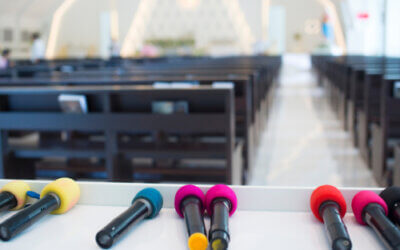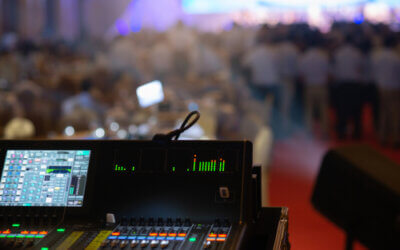When it comes to creating an immersive worship experience in a church setting, the audio-visual system plays a crucial role. However, the importance of acoustics in these systems is often overlooked. In this article, we will delve into the world of church acoustics, discuss the role of audio-visual systems in worship, explore key components of these systems, and provide tips for designing an acoustically optimized AV system for a church.
Understanding Acoustics in Churches
Acoustics is the science of sound and its behavior in a given space. In a church setting, the acoustics significantly influence the quality of the audio signal, which in turn determines the overall worship experience.
The Unique Architecture of Churches
Churches are known for their distinct architecture, featuring high ceilings, vaulted spaces, and often hard surfaces such as stone or glass. These architectural elements contribute to both the visual beauty and acoustic complexity of the space. In addition, the variability and uniqueness of churches’ designs mean that there is no one-size-fits-all solution for church acoustics. The challenge lies in leveraging these unique features to create a space with balanced sound characteristics that enhance the worship experience.
How Sound Waves Travel in Large Spaces
Sound travels in waves, which expand and interact with the environment. In large spaces, such as churches, sound waves can bounce off walls, ceilings, and other surfaces. This can create a series of reflections that make listening to speech and music challenging. Understanding how sound waves travel in these large spaces is the first step in addressing the acoustical challenges posed by church environments.
By taking into account the paths of sound waves and their reflections, audio professionals can create a plan to optimize the church’s sound system, ensuring that the audio is clear and intelligible.
Reverberation and Echoes in Church Settings
Reverberation is the persistence of sound in a space after the initial sound has stopped. It is often experienced as a lush, full sound that adds depth to the music, particularly in a church setting. However, too much reverberation can render speech less intelligible and may negatively affect music performance.
Echoes, on the other hand, occur when sound reflections are delayed significantly, creating distinct, separate repetitions of the original sound. In a church setting, echoes can be distracting and disruptive to the worship experience. Addressing these acoustical issues is essential for creating a balanced and engaging environment.
The Role of Audio-Visual Systems in Worship
Audio-visual systems play a critical role in supporting and enhancing worship services. As technology continues to advance, churches are harnessing the potential of these systems to enhance the spiritual experience of their congregations. From the harmonious blending of sound to the captivating visuals that accompany a worship service, audio-visual systems play a vital role in creating an immersive and transformative worship environment.
Enhancing the Worship Experience
Music and spoken word are central components of worship. Properly designed and implemented audio-visual systems ensure that these elements are presented clearly and effectively. By improving the clarity and intelligibility of speech and music, the overall worship experience is elevated.
In addition, visual displays can help engage the congregation, showcasing lyrics, images, and multimedia content that complement the service.
Supporting Sermons and Presentations
Sermons and presentations provide an opportunity for ministers and congregation members to share knowledge and insights with the community. A well-designed AV system ensures that the speaker’s message is heard clearly and that any accompanying visual content is presented effectively.
When a church’s audio and visual systems work together seamlessly, the congregation can better focus on the content being presented and engage more deeply with the service.
Facilitating Community Engagement
Churches serve as gathering spaces for community events and social activities. Audio-visual systems can support these gatherings by providing a platform for sharing information, showcasing multimedia content, and facilitating communication among attendees. By providing an inviting and engaging atmosphere, churches can foster a strong sense of community and promote fellowship among their congregants.
Key Components of Church Audio-Visual Systems
An effective church audio-visual system comprises of several key components that serve as the backbone of a captivating and immersive worship experience. From meticulously engineered sound systems to visually stunning displays, these components work in harmony to create a profound impact on those attending service.
Microphones and Sound Reinforcement
Microphones are essential for capturing and amplifying the voices of speakers, musicians, and singers. There are various types of microphones, each suited to a specific purpose, such as handheld, lapel, headset, and instrument microphones. Selecting the proper microphone for each application will ensure that each sound source is captured with clarity and precision. Sound reinforcement involves the use of mixing consoles, amplifiers, and speakers to distribute the captured audio signals throughout the worship space, ensuring that the sound is adequately projected and balanced for every listener.
Mixing Consoles and Signal Processing
A mixing console is the central hub for managing and controlling the various audio signals within a church’s AV system. It allows for the adjustment of input levels, equalization, and other effects and is critical for achieving a well-balanced sound mix. Skilled operation of the mixing console is essential for maintaining an engaging and immersive worship experience.
Signal processors, such as compressors, limiters, and equalizers, enable further refinement and control of the audio signal. These tools can be crucial in maintaining a high level of audio quality and addressing specific acoustic challenges within the church environment.
Speakers and Amplifiers
Speakers play a central role in the projection of sound within the worship space. Properly chosen and strategically placed speakers ensure that the audio fills the space evenly and achieves the desired level of intelligibility.
Amplifiers are used to amplify the audio signals received from the mixing console before they are sent to the speakers. The choice and configuration of amplifiers significantly impact the system’s overall performance and reliability.
Visual Display Technologies
Visual displays, such as projectors and flat-panel screens, contribute to the overall worship experience by showcasing multimedia content, lyrics, and messages that accompany the service. The selection of appropriate display technologies and their proper implementation can greatly enhance the worship experience and foster deeper engagement among the congregation.
Designing an Acoustically Optimized Church AV System
Optimizing the acoustics in a church environment requires careful orchestration of various elements to ensure an immersive and transformative worship experience. From assessing the acoustic environment to balancing sound absorption and reflection, and implementing effective acoustic treatments, each step plays a crucial role in achieving quality sound.
Assessing the Acoustic Environment
The first step in addressing acoustics is to assess the existing environment. This may involve taking room measurements, evaluating the impact of architectural features, and identifying any specific acoustical challenges, such as excessive reverberation or echoes. In some cases, consulting with an acoustician or AV professional is recommended to ensure a thorough and accurate assessment of the space.
Balancing Sound Absorption and Reflection
A balanced acoustic environment requires a combination of sound-absorbing materials (to reduce reverberation) and sound-reflecting surfaces (to preserve the character and clarity of the audio). Striking this balance may involve the strategic placement of acoustic panels or other treatments that control sound reflections and absorption.
Implementing Acoustic Treatments
Addressing acoustical challenges may require the installation of various acoustic treatments, such as diffusers, bass traps, and absorptive materials. These tools can be effective in managing reverberation, echoes, and other problematic sound characteristics, enhancing the overall audio-visual experience in the church. Professional assistance is important in determining the optimal placement and configuration of these treatments for your specific environment.
Choosing the Right Audio-Visual Equipment
Finally, selecting the appropriate audio-visual equipment for your church’s specific needs and environment is essential. This includes choosing the right microphones, speakers, amplifiers, and visual display technologies, as well as any other audio or visual components necessary for a high-quality, engaging worship experience.
Seeking the guidance of AV professionals like Division 16, evaluating reviews and recommendations, and considering the unique characteristics of your church environment will help ensure that your equipment choices result in an effective, reliable, and immersive audio-visual system.
Understanding and addressing acoustics is a critical aspect of designing and maintaining an effective church audio-visual system. By taking the time to consider the unique acoustic challenges in your environment, investing in the right equipment and treatments, and seeking professional guidance when necessary, you can create a worship experience that is immersive, engaging, and spiritually uplifting for everyone in your congregation.
Whether you’re looking to update the A/V system for your house of worship, or just want to find out more about us, feel free to get in touch.
To see how we’ve helped another church with AV, read our case study on Radiant Church of Bay City:




